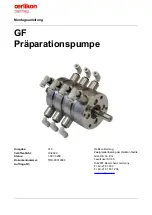
39
ENGLISH
ENGLISH
SAFETY AND POLLUTION
General considerations
The machine has been designed with a view to reducing the risks to persons and the environment in which it is installed, to the
minimum. To eliminate residue hazards, it is therefore advisable to become as familiar as possible with the machine in order to
avoid accidents that could cause injuries to persons and/or damage to property.
a. Access to the unit
Only qualified persons who are familiar with this type of machine and who are equipped with the necessary safety protections
(footwear, gloves, helmet, etc.) may be allowed to access the machine. Moreover, in order to operate, these persons must have
been authorized by the owner of the machine and be recognized by the actual Manufacturer.
b. Elements of risk
The machine has been designed and built so as not to create any condition of risk. However, residue hazards are impossible to
eliminate during the planning phase and are therefore listed in the following table along with the instructions about how to neu-
tralize them.
c. Pollution
The machine contains
R22
or
R407C
refrigerant and lubricating oil. If the unit is scrapped, these fluids must be recovered and
disposed of in accordance with the laws in force in the country where the machine is installed.
The machine must not be aban-
doned when scrapped.
General recommendations about the refrigerant used
The cooling circuit of the machine is filled with
R22
or
R407C
refrigerant gas. If it escapes, this gas will damage the
atmospheric ozone. When it is no longer required for use, the machine must be consigned to the specific waste collection autho-
rities. Information about the characteristics of the refrigerant and what to fo if it accidentally spills, are
given below.
Danger indication
•
Low toxicity
•
Inhalation of the gas for long periods can have anaesthetic effects.
•
Prolonged exposure can alter the heart rate and cause death.
•
The product can cause ice burns on the eyes and/or skin.
Limits to long-term professional exposure (LTEL)
R22
Dangerous component....................................LTEL limit
ppm
R22 - Mono Chlorodifluoromethane CHCIF
2
........1000
R407C
Ternary mixture of R-32 (23%), R-125 (25%) and R134a (52%)
Dangerous component....................................LTEL limit
ppm
R-32 - Difluoromethane CH
2
F
2
............................1000
R-125 - Pentafluoroethane CH
2
F
3
.........................1000
R-134a- 1,1,1,2 - Tetrafluoroethane CH
2
F CF
3
.......1000
Part in question
Residue hazard
Operating
Precautions
Compressor and delivery
pipe
Burns
Contact with the pipes and/or
(VM)
Avoid contact by wearing
protective gloves
Delivery pipes and coils
Explosion
Excessive pressure
Turn off the machine,
check the high pressure
switch, the fans and the
condenser
Pipes in general
Ice burns
Leaking refrigerant and con-
tact with the skin
Do not pull on the pipes
Electrical cables, metal parts
Electrocution, serious burns Defective cable insulation, live
metal parts
Adequate electrical protection
(correctly ground the unit)
Heat exchange coils
Cuts
Contact
Wear protective gloves
Install the “Protective coil gril-
les” accessory
Electric fans
Cuts
Contact
Do not push the hands or
objects through the fan
grilles




































